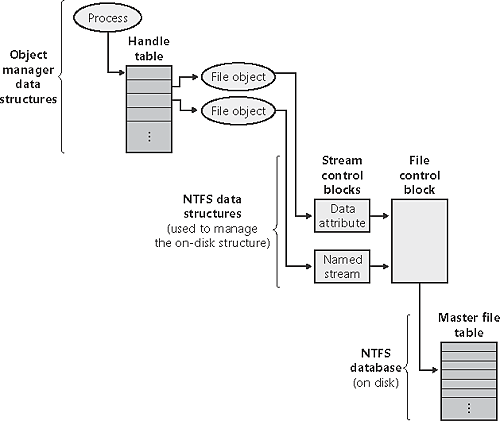NTFS File System Driver
| < Day Day Up > |
| As described in Chapter 9, in the framework of the Windows I/O system, NTFS and other file systems are loadable device drivers that run in kernel mode. They are invoked indirectly by applications that use Windows or other I/O APIs (such as POSIX). As Figure 12-20 shows, the Windows environment subsystems call Windows system services, which in turn locate the appropriate loaded drivers and call them. (For a description of system service dispatching, see the section "System Service Dispatching" in Chapter 3.) Figure 12-20. Components of the Windows I/O system
The layered drivers pass I/O requests to one another by calling the Windows executive's I/O manager. Relying on the I/O manager as an intermediary allows each driver to maintain independence so that it can be loaded or unloaded without affecting other drivers. In addition, the NTFS driver interacts with the three other Windows executive components, shown in the left side of Figure 12-21, that are closely related to file systems. Figure 12-21. NTFS and related components
The log file service (LFS) is the part of NTFS that provides services for maintaining a log of disk writes. The log file LFS writes is used to recover an NTFS-formatted volume in the case of a system failure. (See the section "Log File Service (LFS).") The cache manager is the component of the Windows executive that provides systemwide caching services for NTFS and other file system drivers, including network file system drivers (servers and redirectors). All file systems implemented for Windows access cached files by mapping them into system address space and then accessing the virtual memory. The cache manager provides a specialized file system interface to the Windows memory manager for this purpose. When a program tries to access a part of a file that isn't loaded into the cache (a cache miss), the memory manager calls NTFS to access the disk driver and obtain the file contents from disk. The cache manager optimizes disk I/O by using its lazy writer threads to call the memory manager to flush cache contents to disk as a background activity (asynchronous disk writing). (For a complete description of the cache manager, see Chapter 11.) NTFS participates in the Windows object model by implementing files as objects. This implementation allows files to be shared and protected by the object manager, the component of Windows that manages all executive-level objects. (The object manager is described in the section "Object Manager" in Chapter 3.) An application creates and accesses files just as it does other Windows objects: by means of object handles. By the time an I/O request reaches NTFS, the Windows object manager and security system have already verified that the calling process has the authority to access the file object in the way it is attempting to. The security system has compared the caller's access token to the entries in the access-control list for the file object. (See Chapter 8 for more information about access-control lists.) The I/O manager has also transformed the file handle into a pointer to a file object. NTFS uses the information in the file object to access the file on disk. Figure 12-22 shows the data structures that link a file handle to the file system's on-disk structure. Figure 12-22. NTFS data structures NTFS follows several pointers to get from the file object to the location of the file on disk. As Figure 12-22 shows, a file object, which represents a single call to the open-file system service, points to a stream control block (SCB) for the file attribute that the caller is trying to read or write. In Figure 12-22, a process has opened both the unnamed data attribute and a named stream (alternate data attribute) for the file. The SCBs represent individual file attributes and contain information about how to find specific attributes within a file. All the SCBs for a file point to a common data structure called a file control block (FCB). The FCB contains a pointer (actually, a file reference, explained in the section "File Reference Numbers" later in this chapter) to the file's record in the disk-based master file table (MFT), which is described in detail in the following section. |
| < Day Day Up > |
EAN: 2147483647
Pages: 158

